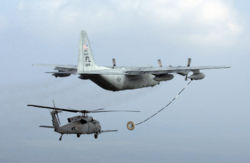PlaneSpottingWorld welcomes all new members! Please gives your ideas at the Terminal.
HH-60 Pave Hawk
| HH-60G Pave Hawk | |
|---|---|
| USAF HH-60G Pave Hawk helicopter | |
| Type | Combat Search and Rescue helicopter |
| Manufacturer | Sikorsky Aircraft Corporation |
| Primary user | United States Air Force |
| Unit cost | US$15.8 million |
| Developed from | Sikorsky S-70 |
| Variants | UH-60 Black Hawk SH-60B Seahawk HH-60J Jayhawk |
The primary function of the Sikorsky HH-60G Pave Hawk helicopter is to conduct day or night combat search and rescue (CSAR) operations into hostile environments to recover downed aircrew or other isolated personnel during war. Because of its versatility, the HH-60G may also perform peace-time operations. Such tasks include civil search and rescue, emergency aeromedical evacuation (MEDEVAC), disaster relief, international aid, counter-drug activities and NASA space shuttle support.
Design
The Pave Hawk is a highly-modified version of the Sikorsky UH-60 Black Hawk helicopter, manufactured by United Technologies and Sikorsky Aircraft Corporation and first deployed in 1982. It features an upgraded communications and navigation suite that includes an integrated inertial navigation/global positioning/Doppler navigation systems, satellite communications, secure voice, and Have Quick communications. Pave Hawks cost an estimated $15.8 million (U.S. dollars, 1998) each to construct.
All HH-60Gs have an automatic flight control system, night vision goggles lighting and forward looking infrared system that greatly enhances night low-level operations. Additionally, some Pave Hawks have color weather radar and an engine/rotor blade anti-ice system that gives the HH-60G an all-weather capability.
Pave Hawk mission equipment includes a retractable in-flight refueling probe, internal auxiliary fuel tanks, two crew-served (or pilot-controlled) 7.62 mm machine guns and an 8,000 pound (3,600 kg) capacity cargo hook. The aircraft now also has the ability to mount .50 cal machine guns instead of the 7.62's. To improve air transportability and shipboard operations, all HH-60Gs have folding rotor blades.
Pave Hawk combat enhancements include a radar warning receiver, infrared jammer and a flare/chaff countermeasure dispensing system.
HH-60G rescue equipment includes a hoist capable of lifting a 600 pound (270 kg) load from a hover height of 200 feet (60 m), and a personnel locating system that is compatible with the PRC-112 survival radio and provides range and bearing information to a survivor's location.
A limited number of Pave Hawks are equipped with an over-the-horizon tactical data receiver that is capable of receiving near real-time mission update information.
Operation

The Pave Hawk is a twin-engine medium-lift helicopter operated by Air Combat Command (ACC), Pacific Air Forces, Air Education and Training Command, Air National Guard and Air Force Reserve Command.
During Operation Desert Storm Pave Hawks provided combat search and rescue coverage for coalition Air Forces in western Iraq, Saudi Arabia, coastal Kuwait and the Persian Gulf. They also provided emergency evacuation coverage for U.S. Navy sea, air and land (SEAL) teams penetrating the Kuwaiti coast before the invasion.
During Operation Allied Force, the Pave Hawk provided continuous combat search and rescue coverage for NATO air forces, and successfully recovered two U.S. Air Force pilots who were isolated behind enemy lines.
In March 2000, three Pave Hawks deployed to Hoedspruit Air Force Base in South Africa, to support international flood relief operations in Mozambique. The HH-60Gs flew 240 missions in 17 days and delivered more than 160 tons of humanitarian relief supplies.
Air Force Pave Hawks from the Pacific Theatre also took part in a massive humanitarian relief effort in early 2005 in Sri Lanka to help victims of the tsunami.
In the fall of 2005, Pave Hawks from various Air Force commands participated in rescue operations of Hurricane Katrina survivors, rescuing thousands of stranded people.
Currently, Pave Hawks regularly operate in Operation Enduring Freedom and Operation Iraqi Freedom supporting Army combat operations.
Specifications (HH-60)
General characteristics
- Crew: 4 (2 pilots, flight engineer, gunner)
- Length: 64 ft 10 in (17.1 m)
- Rotor diameter: 53 ft 8 in (14.1 m)
- Height: 16 ft 8 in (5.1 m)
- Empty weight: 16,000 lb (7,260 kg)
- Loaded weight: 21,000 lb (9,525 kg)
- Max takeoff weight: 22,000 lb (9,900 kg)
- Powerplant: 2× General Electric T700-GE-701 free-turbine turboshafts, 1,630 shp (1,220 kW) each
Performance
- Maximum speed: 193kts (295 km/h)
- Range: 505 mi, unlimited with air refueling (815 km)
- Service ceiling: ft (m)
- Rate of climb: ft/min (m/s)
- Disc loading: lb/ft² (kg/m²)
- Power/mass: hp/lb (kW/kg)
Armament
- 2x 7.62 mm or 0.50 cal machine guns
Related content
Related development
- Sikorsky S-70
- Sikorsky UH-60 Black Hawk
- Sikorsky SH-60 Seahawk
- Sikorsky HH-60 Jayhawk
- H-92 Superhawk
Designation sequence
- U.S. Military:
- Sikorsky:
Related lists
Template:Active military aircraft of the United States
See also
Lists relating to aviation | |
|---|---|
| General | Timeline of aviation · Aircraft · Aircraft manufacturers · Aircraft engines · Aircraft engine manufacturers · Airports · Airlines |
| Military | Air forces · Aircraft weapons · Missiles · Unmanned aerial vehicles (UAVs) · Experimental aircraft |
| Notable incidents and accidents | Military aviation · Airliners · General aviation · Famous aviation-related deaths |
| Records | Flight airspeed record · Flight distance record · Flight altitude record · Flight endurance record · Most produced aircraft |


